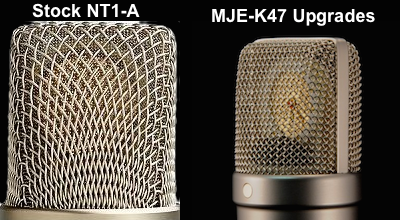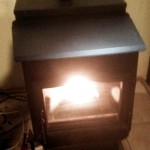A Custom OktavaMod Microphone from Michael Joly Engineering Replaces my CAD E100S
Up until very recently, all of my voiceover work was recorded on a CAD E100S. Then, I got a chance to hear one of Michael Joly’s custom microphones, and everything changed…
Let me start by saying, I loved my CAD E100S. Flat response, low self-noise, and tight pick up pattern, what’s not to love? The E100S was very clean and true. The hypercardioid pattern was great for off-axis rejection. I never thought that I would want another mic, until I found out about the ones built by Michael Joly.
Michael Joly runs his business from a small workshop on Cape Cod, here in Massachusetts. In it, he takes common, in-expensive microphones and tricks them out. After his modifications, its nearly impossible to distinguish his mics from ones costing thousands of dollars more.
I first got to hear one of his microphones at a live performance. My ears could swear that they were hearing a high end tube microphone, or maybe an active ribbon mic, but that’s not what my eyes were seeing. What I saw looked like a run-of-the-mill Nady TCM-1050! A few days later, I connected with the performer online and found out that this particular TCM-1050 had been upgraded by Michael Joly.
Choosing & Buying My Microphone
I looked through the microphones on his site, and true to form, I decided to order “off menu”.
I explained that I really liked the sound of his tube mic upgrade and the sound of his VintageVoice’d MJE-250, but I do voiceover from a small StudioBricks booth in my personal studio. And, I knew that he usually recommended his Røde NT1-A upgrade for voice work.
His response — He offered to upgrade the lower self-noise NT1-A with the VintageVoice’d capsule!
Ordering the microphone from his website was easy. I got automated emails telling me the status of my order all the way through to shipping. And, about a week later, I received my microphone.
 Opening the box, almost everything was stock Røde NT1-A — the shock mount, pop filter, and sleeve all come standard with an NT1-A. The small MJ (Michael Joly) logo affixed to the front of the mic, and the certificate explaining the modifications were the only immediate clues that there was anything different here.
Opening the box, almost everything was stock Røde NT1-A — the shock mount, pop filter, and sleeve all come standard with an NT1-A. The small MJ (Michael Joly) logo affixed to the front of the mic, and the certificate explaining the modifications were the only immediate clues that there was anything different here.
If you compare my microphone to a stock NT1-A side by side, you can see a few other differences. The new single-layered open basket makes the new custom capsule more evident. But, without a direct comparison, you’d be forgiven for not noticing the change.
But, that’s enough about how it looks. It’s a microphone after all, what’s important is how it sounds.
Here are some sample WAV files. They’re big. They may take a while to load…
MJE-K47 at 7″ from the capsule
MJE-K47 at 5″ from the capsule
MJE-K47 at 10″ from the capsule
MJE-K47 at all 3 distances with the volumes leveled for easier comparison
MJE-K47 on a longer narrative read – from Words of Love – the chapter titled Romantic Pain
 NOTE: These samples were recorded in a StudioBricks One Plus booth using a Focusrite Forte as an interface. The highpass filter on the Forte was engaged because without it you would hear rumbles from my pellet stove (Hey, it is winter in New England after all).
NOTE: These samples were recorded in a StudioBricks One Plus booth using a Focusrite Forte as an interface. The highpass filter on the Forte was engaged because without it you would hear rumbles from my pellet stove (Hey, it is winter in New England after all).
Evaluating the Microphone
Paul Strikwerda posted wonderfully detailed reviews of the CAD E100S and the Gefell M930 where he came up with 8 criteria to look for when rating a microphone for voiceover work:
- Minimal voice coloration
- Tight pick-up pattern (cardioid or supercardioid)
- Excellent rear rejection
- Controlled proximity effect (bass boost)
- Low susceptibility to sibilance (shrill “S”-sounds) and popping
- Low self-noise
- High-pass filter to cut out lower frequencies
- Rugged design, ready for the road
Let’s go through these one at a time…
Minimal Voice Coloration
Both the E100S and the MJE-K47 tie on this point. Neither add unwanted flavors to the audio. They both seem to accurately represent what they hear.
That said, you might remember, in a previous post, where I mentioned that a good thing to ask other people would be, “Does it sound like me?” To get the E100S to a point where people would universally respond “yes,” I needed a small EQ bump at about 220Hz and a slight drop near 8000Hz. The bump added a bit of presence and the drop shaved off a touch of sibilance (more on that later).
Asking that same question of the raw audio from the MJE-K47, I was greeted with a universal, “It’s perfect just the way it is. Don’t change a thing.”
In analysing exactly what the differences were in the 2 mics, I am starting to believe that the E100S was hearing more of the booth than the MJE-K47. I think I detected a bit of destructive interference around 220Hz caused by reflection from the flat surface on the door to my booth. And, I think a reflection from the computer screen that I read copy from was over-emphasizing my sound at around 8000Hz adding a bit of sibilance.
So, though, in a lab, the 2 mics might be equal, in my real world application, the MJE-K47 did a better job of letting me sound like me.
Tight Pick-Up Pattern
The E100S has a tighter pick-up pattern than the MJE-K47. The E100S’s pattern is tight enough that many of the tricks that one learns when working a Sennheiser MKH416 shotgun mic actually do help on an E100S. The pattern on the E100S is so tight that you do need to work to maintain a constant position. Even small changes in how you stand or sit will affect the sound.
The MJE-K47 is much more forgiving. It allows me the freedom to act with my body as well as my voice. The pattern is more of a traditional cardioid one which, as I have said, seems to work better in small spaces like my booth.
Excellent Rear Rejection
Surprisingly, the MJE-K47 beats the E100S here though it may seem counter-intuitive at first. If you look at a good diagram of both Cardioid and Hypercardioid patterns, you will see that the bump behind the mic is bigger for the E100S. And, inside my booth, behind the mic is where you can find the powered air vent.
My layout options are limited inside the StudioBricks One Plus. The vent can either be behind the microphone or just beyond my left elbow. Either way, it hears the vent. Check out this video for more details about Cardioid vs Hypercardioid patterns…
Controlled Proximity Effect
This one is a draw. Both mics get a workable bit of proximity effect starting at about 5 inches.
By the way, the E100S also can get warm resonance in the same way that a Sennheiser MKH416 can, point it at your upper chest instead of your mouth. If you’ve considered an MKH416 but really need a Large Diaphragm condenser microphone, you should really consider an E100S, in my opinion, it’s as close as you are going to get with an LDC.
Low Susceptibility to Sibilance
The MJE-K47 wins hands down. A sibilance-free top end is part of what Michael Joly advertises, and he’s not kidding. Check out the Sibilance Torture Test Shootout on his site.
I am convinced that the E100S is not a sibilant mic in and of itself. It seems to become one when used within my booth. This is a case of the environment affecting the sound quality, not the microphone.
Low Self-Noise
The E100S technically wins on this one (3.7 compared to 5.0 dBA), but the difference is so minimal that I can’t hear the difference. I am pretty sure that you won’t either.
High Pass Filter
The E100S has one and the other mic does not. I prefer to record the entire signal whenever possible (I’ll be turning off the High Pass in my interface once heating season in New England ends). So this one isn’t a big deal for me either. The built-in High Pass on the E100S seems to actually raise the noise floor of the mic. At first I thought that I had a defective unit, but I have checked with other people and it seems to be true across the board.
Rugged Design
The E100S wins on this point. Not only is it built like a tank but it also comes in a solid wood box. I don’t plan on traveling with this mic. So, as long as it feels solid and works well in my vocal booth, I am happy. The MJE-K47 is a featherweight compared to the E100S, but it is not actually that delicate. Michael Joly only upgrades microphones that have proven themselves to be solid. I trust his judgement in choosing the NT1-A body.
Concluding Thoughts
In the end, I decided that Michael Joly’s MJE-K47 was the better microphone for me. It effortlessly handles the quirks of both my delivery and of the booth in which I work. I think that it is an amazing microphone for the price. If you’re looking for a new microphone, you should definitely peruse his website and consider dropping him an email.
The CAD E100S is a great microphone, but it’s just not for me. If you’ve been considering a Sennheiser MKH416 for voice work, but know that you need the distinctive nuance that you can get from a Large Diaphragm Condenser, you should definitely check out the E100S.
☕ Cup of Coffee
A ridiculous amount of caffeine was consumed while researching.
Add some fuel if you would like to help keep me going!

